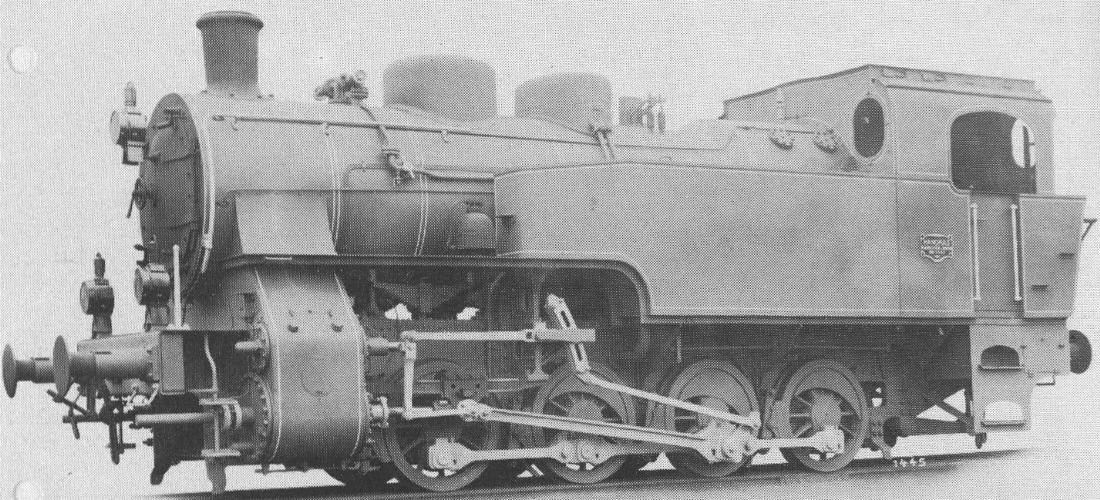Hanomag type Dresden
| Hanomag type Dresden | |
|---|---|
|
Factory photo Hanomag
|
|
| Numbering: |
Lothringen VI mine and others |
| Number: | about 6 |
| Manufacturer: | Hanomag |
| Year of construction (s): | 1924 |
| Retirement: | unknown |
| Type : | D n2t |
| Gauge : | 1435 mm ( standard gauge ) |
| Length over buffers: | 10,330 mm |
| Length: | 9,030 mm |
| Height: | 3,800 mm |
| Width: | 2,800 mm |
| Total wheelbase: | 4,000 mm |
| Empty mass: | 43.1 t |
| Service mass: | 56.3 t |
| Friction mass: | 56.3 t |
| Wheel set mass : | 14 t |
| Top speed: | 40 km / h |
| Driving wheel diameter: | 1,050 mm |
| Control type : | Heusinger |
| Number of cylinders: | 2 |
| Cylinder diameter: | 520 mm |
| Piston stroke: | 500 mm |
| Boiler overpressure: | 13 bar |
| Grate area: | 2.4 m² |
| Evaporation heating surface: | 146.95 m² |
| Water supply: | 5.4 m³ |
| Fuel supply: | 1.7 t |
| Brake: | Vapor barrier and handbrake |
The tank locomotives of the Hanomag type Dresden series were steam locomotives with the wheel arrangement D, which were supplied by the manufacturer Hanomag to various industrial companies from 1924 .
history
The locomotives belonged to the 2nd type program of standard factory locomotives from the manufacturer Hanomag . They were the largest locomotives in this series. The actual number of locomotives produced is not known.
We know of six delivered locomotives:
- Factory number 10350 to the Lothringen colliery , number VI there
- Factory number 10376 to customers in France
- Factory number 10426 to the Diergardt colliery
- Factory number 10479 to the Böhler brothers
- Factory number 10579 to a chemical factory in Gerthe and
- Factory number 10674 on a coal mine in the Netherlands
None of these are left.
The locomotives were created at a time when the standardization of parts for factory and metallurgical locomotives led to typification. This brought cost reductions with it, as customers could request spare parts directly from the factory without having to maintain a spare parts store themselves. Around 70% of all parts in the range were identical and therefore interchangeable. This development resulted in the unification efforts of the Association of German Trams and Small Railways, which resulted in the ELNA locomotive program .
technology

The locomotives were designed as hut locomotives, with the great locomotive friction load and performance in the foreground. They were made of materials that corresponded to the regulations of the German Locomotive Construction Association and operated with wet steam in order to minimize maintenance effort and susceptibility to failure. They had a simple sheet metal frame with an integrated water tank. Further water supplies were carried in the side boxes. The coals were stored in the left side box up to the driver's cab and in the rear box.
The engine of the locomotive worked on the third axis and had a Heusinger control with piston valves . The first three axes were fixed in the frame, the fourth axis could be moved 15 mm to each side. The locomotives were equipped with vapor brakes and hand brakes, and all wheels were braked from the front.
The basic equipment included Friedmann lubrication pump, hand-held sand spreader and steam flute unit. The locomotives had a sandpit with two sand pipes on each side of the engine, these sanded the second axis in the direction of travel. The bell was attached to the left circulating sheet in front of the water tank.
A variant of the Hanomag type Dresden was manufactured with very long water boxes reaching to the front of the smoke chamber and a low design. This design can only be found on historical pictures.
literature
- Lothar Spielhoff: HANOMAG locomotives . Podszun engine books, Brilon 2004.
- Klaus-Joachim Schrader: Steam locomotives on works railways . Verlag Wolfgang Zeunert, Gifhorn 1977, p. 26-27 .
Individual evidence
- ↑ Data sheet about the 2nd type range of Hanomag factory railway locomotives at www.dampflokomotivarchiv.de
- ↑ Lothar Spielhoff: HANOMAG locomotives . Podszun engine books, Brilon 2004.
- ^ Klaus-Joachim Schrader: Steam locomotives at works railways . Verlag Wolfgang Zeunert, Gifhorn 1977, p. 75 .
